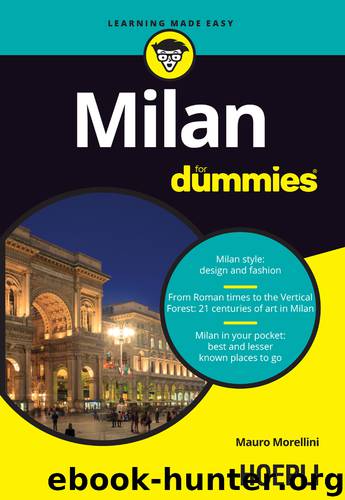Milan for dummies by Mauro Morellini

Author:Mauro Morellini
Language: eng
Format: epub
ISBN: 9788820390037
Publisher: Hoepli
Chapter 5
Gastronomy and restaurants
IN THIS CHAPTER
Breakfasts and Snacks
Starred Restaurants
The Best Trattorias
As one would expect from an international metropolis like Milan, you can find some wonderful regional dishes here and you can also eat every type of cuisine from all over the world.
Seeing that the tastes of our readers are varied too, we have tried to suggest all sorts of different types of places to eat.
Milan is well known for some of its dishes that have emerged from its rich and glorious history. Some originated right here, like panettone or cotoletta alla Milanese (breaded veal or pork); others demonstrate the strong links that Milan has with the countryside close by. For example, some fortifying dishes, often made from simple, easily accessible foods, like nervitt, which is veal cartilage salad, or roasted potato peels, or mondeghili, which are typical meatballs made from leftovers.
Panettone is one of the best-known desserts. Its origins are so buried in the past, that how it was invented and even its name is mixed into legends and theories. Traditionally it is a Christmas dessert, but everyone knows that you can eat it up until the 3rd of February, San Biagio day.
You need to be in Milan in winter if you want to try the Milanese cassoeûla: tradition says the best cassoeûla is made when the cabbage freezes outside. It is a simple meal but quite substantial, adapted to win over even the hardest winters in the countryside. The cabbage is cooked with the less noble parts of the pig (head, rind, feet, ribs).
So, which came first? the Cotoletta alla milanese or the Wiener schnitzel? According to the Milanese, it was marshall Radetzy who discovered the dish during the occupation of Milan in 1848 and then sent the recipe to count Attems in Vienna. Whatever the story, the breaded cutlets were made to look like golden leaves, without having to use very expensive ingredients.
The same “golden” effect was more or less reached by using saffron in another stronghold of Milanese cuisine, saffron risotto or risotto allo zafferano, or sometimes just simply known as “yellow risotto”. It is often served together with Ossobuco. Lombard cheeses from the valleys and plains should definitely not be ignored, especially the two big cheeses that are found in several dishes from around here. Taleggio and then Gorgonzola, or “zola” as it is known locally, which comes from the town with the same name to the east of Milan (where the herds first stopped after their summers in the Alps) Production now however, takes place around the areas of Novara, Como and Pavia.
You will find most restaurants in the same places as the nightlife (see page 75): Isola, Brera, Navigli… although there is also a very interesting district along and around via Monte Nero, close to Porta Romana, which has an endless source of restaurants and trattorias that are truly for every taste. Then via Paolo Sarpi, in the heart of Chinatown, is where you will find Asian food in all its guises.
Download
This site does not store any files on its server. We only index and link to content provided by other sites. Please contact the content providers to delete copyright contents if any and email us, we'll remove relevant links or contents immediately.
Crystal Cove by Lisa Kleypas(38496)
Spell It Out by David Crystal(35857)
Underground: A Human History of the Worlds Beneath Our Feet by Will Hunt(11846)
For the Love of Europe by Rick Steves(11567)
Tools of Titans by Timothy Ferriss(7828)
Giovanni's Room by James Baldwin(6823)
The Rosie Project by Graeme Simsion(5855)
A Year in the Merde by Stephen Clarke(5082)
Perfect Rhythm by Jae(5080)
Beach Read by Emily Henry(5013)
Spare by Prince Harry The Duke of Sussex(4804)
The Body: A Guide for Occupants by Bill Bryson(4595)
Endurance: Shackleton's Incredible Voyage by Alfred Lansing(4518)
China Rich Girlfriend by Kwan Kevin(4301)
The Silk Roads by Peter Frankopan(4277)
A Game of Thrones 1 by George R R Martin(3989)
Tokyo Vice: An American Reporter on the Police Beat in Japan by Jake Adelstein(3869)
The Motorcycle Diaries by Ernesto Che Guevara(3795)
Alive: The Story of the Andes Survivors by Piers Paul Read(3743)
